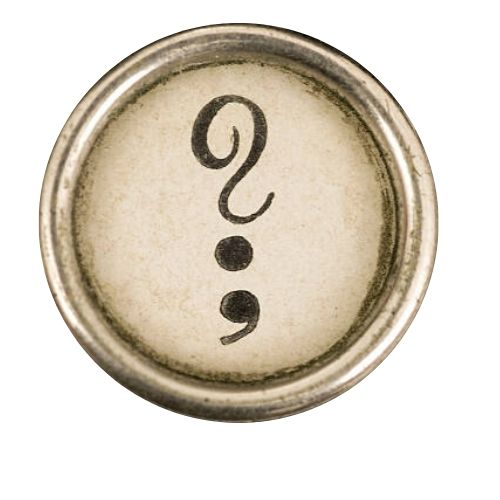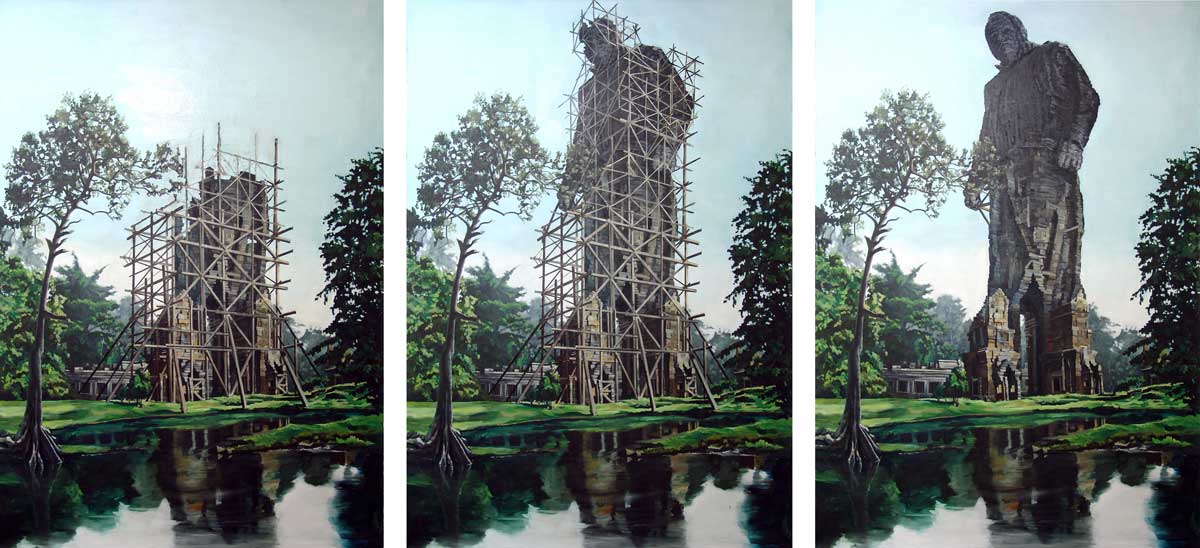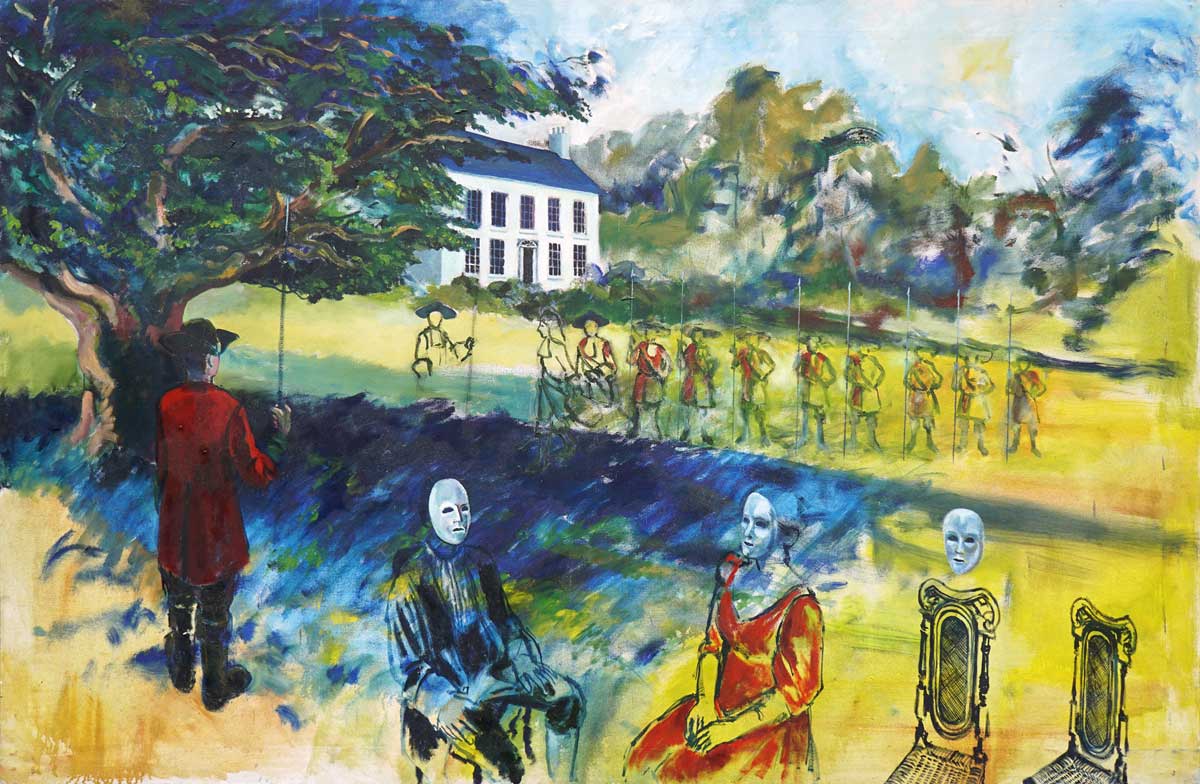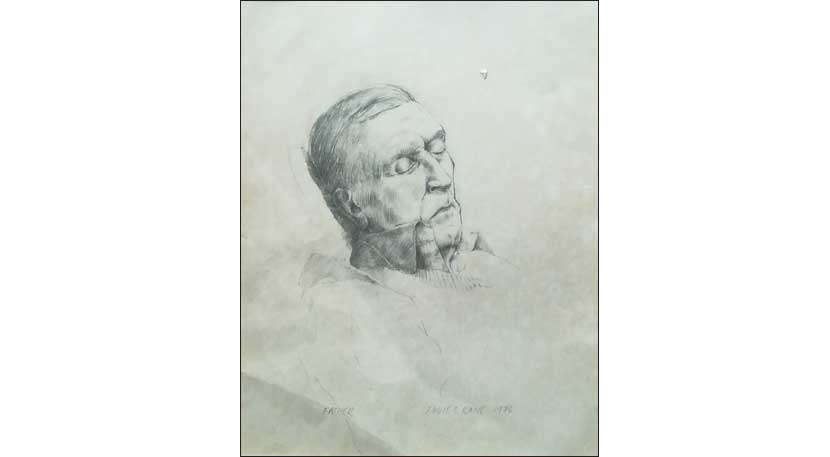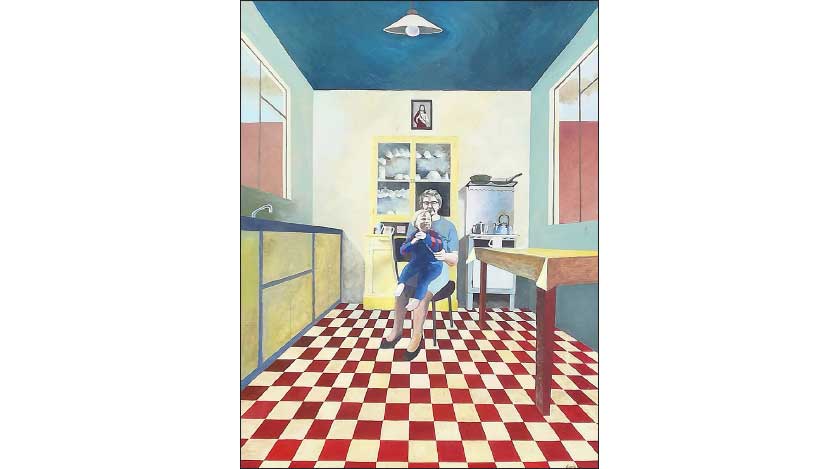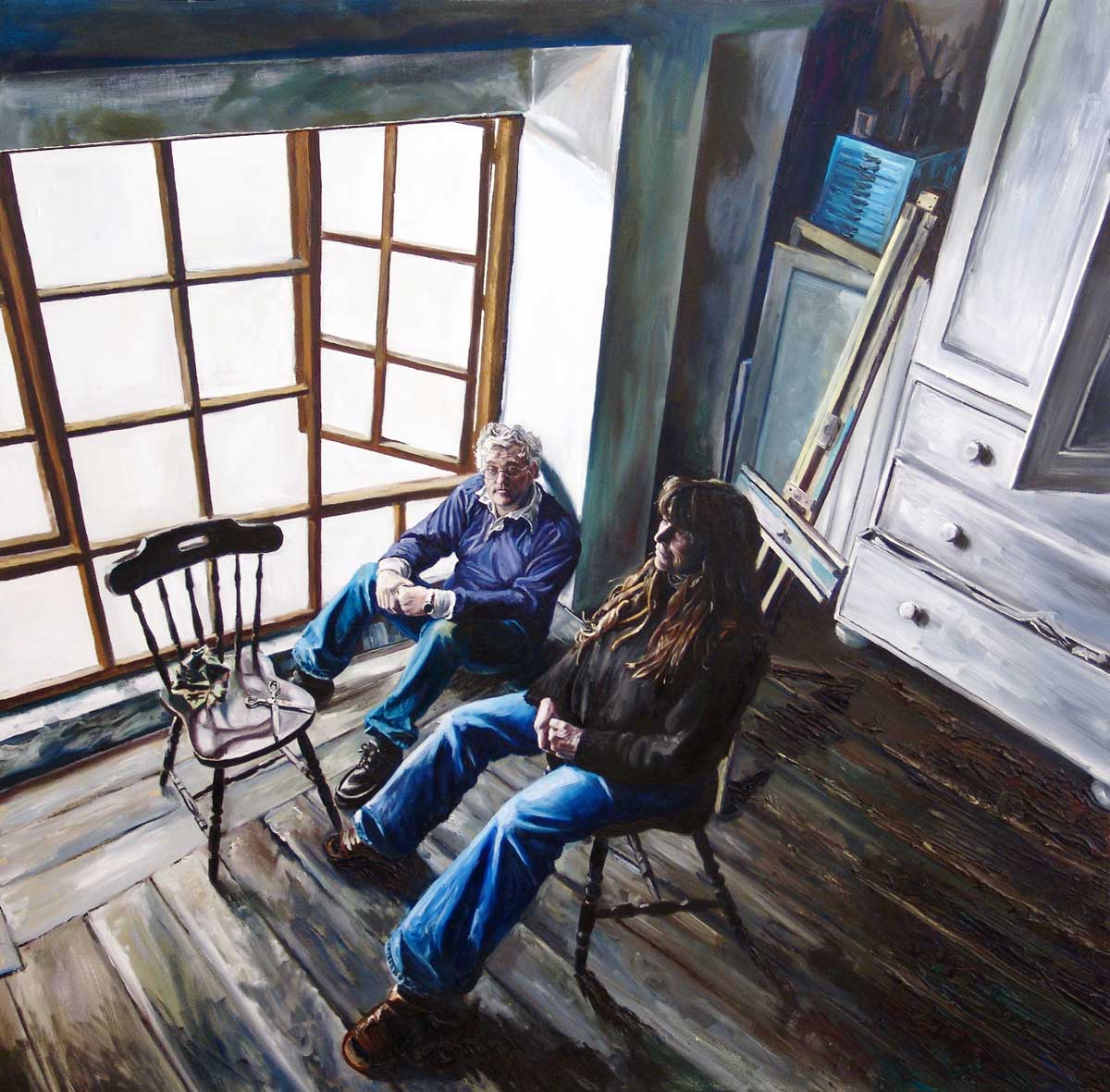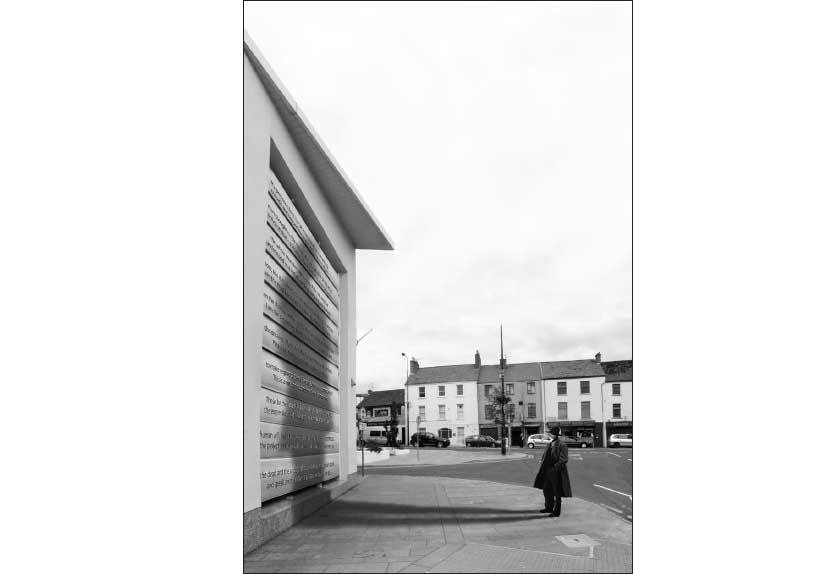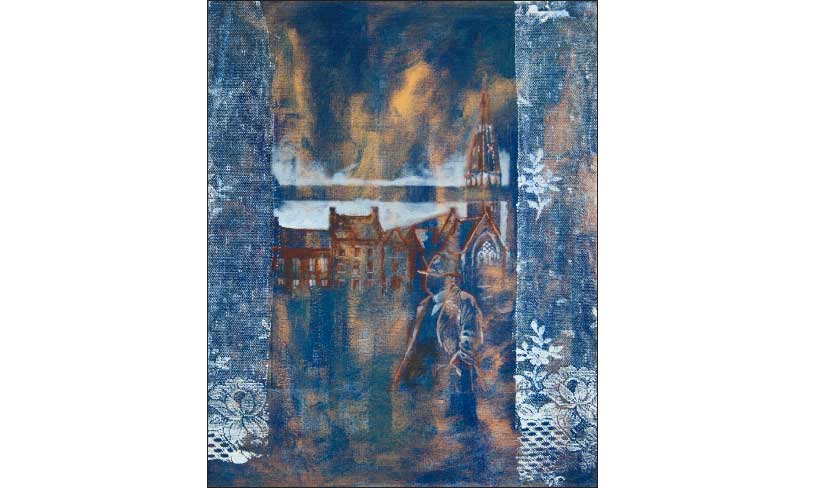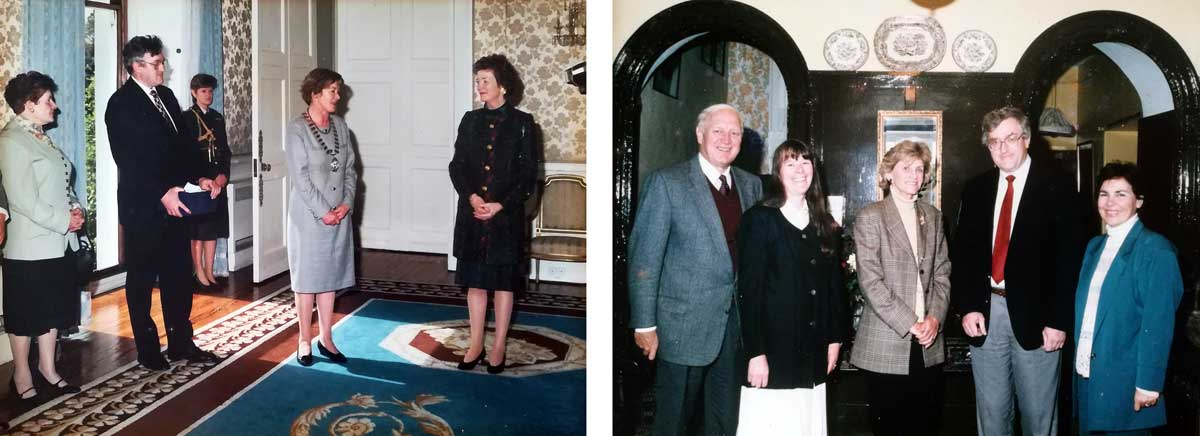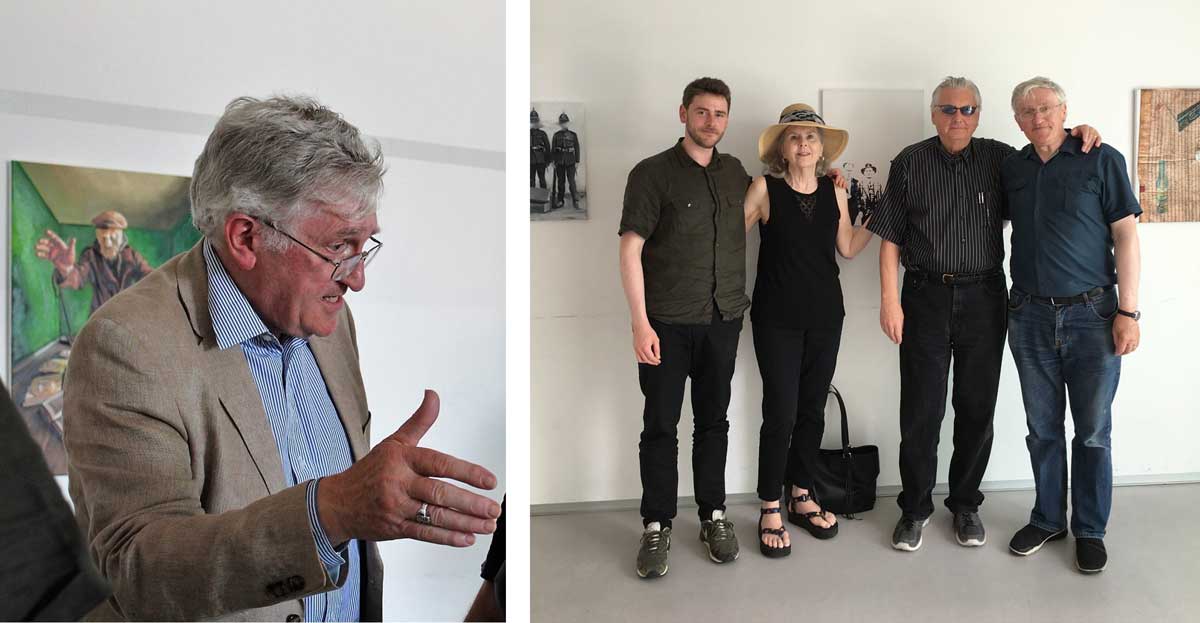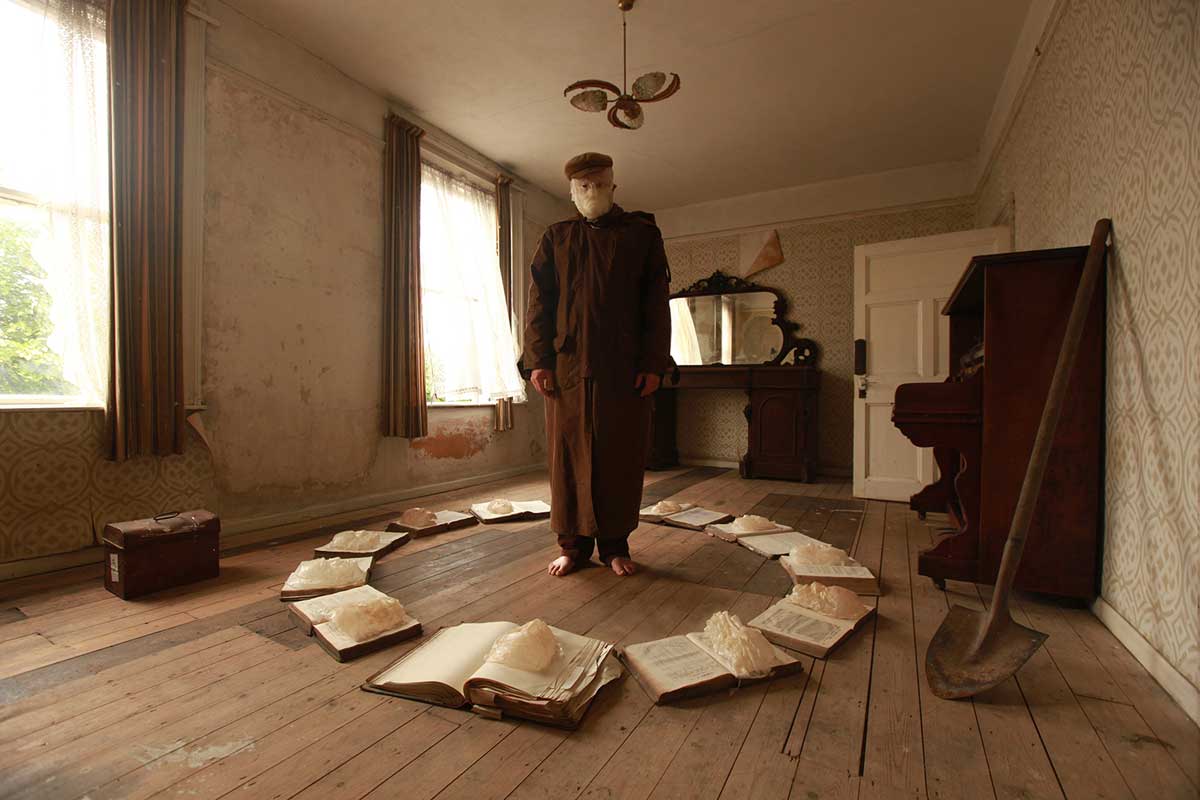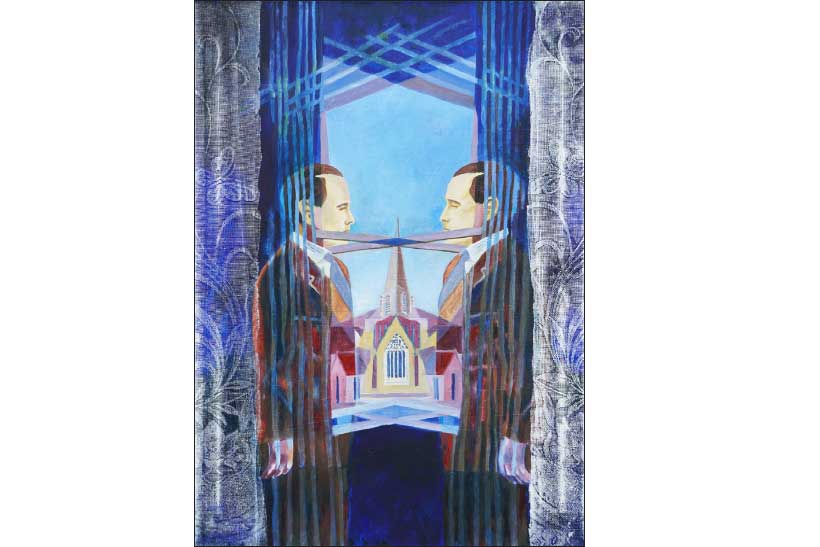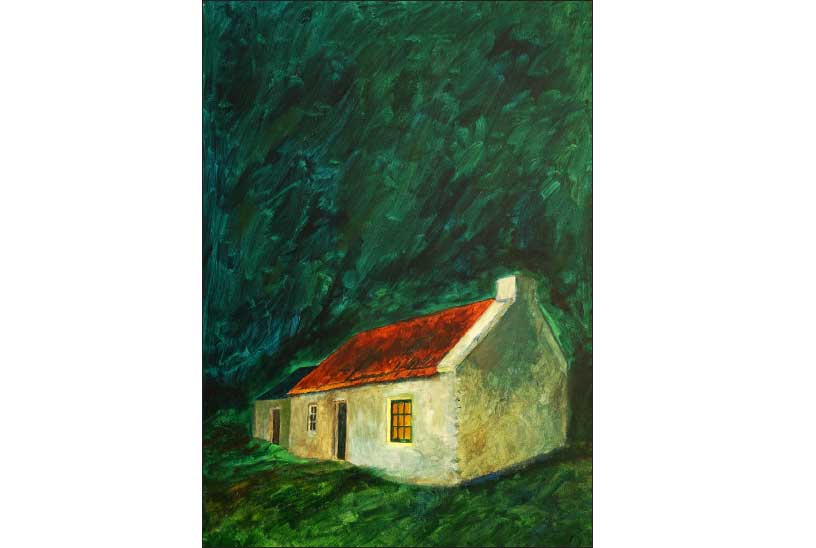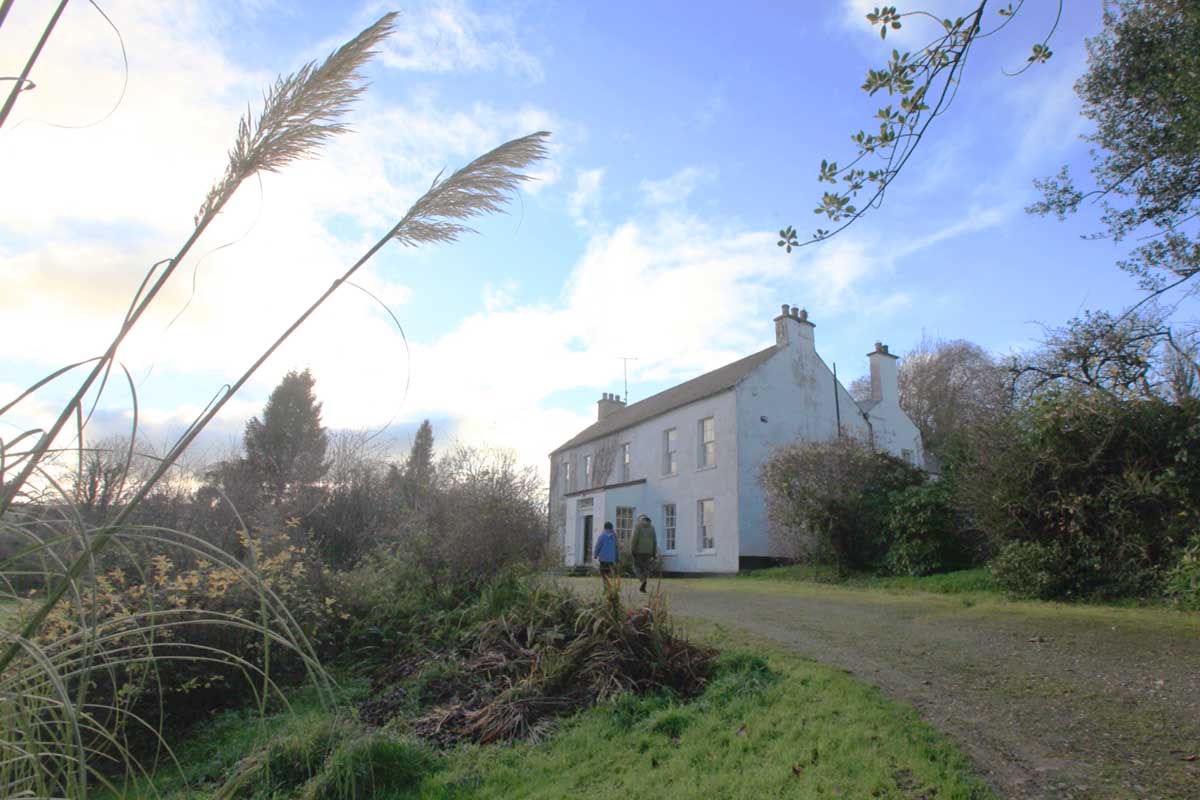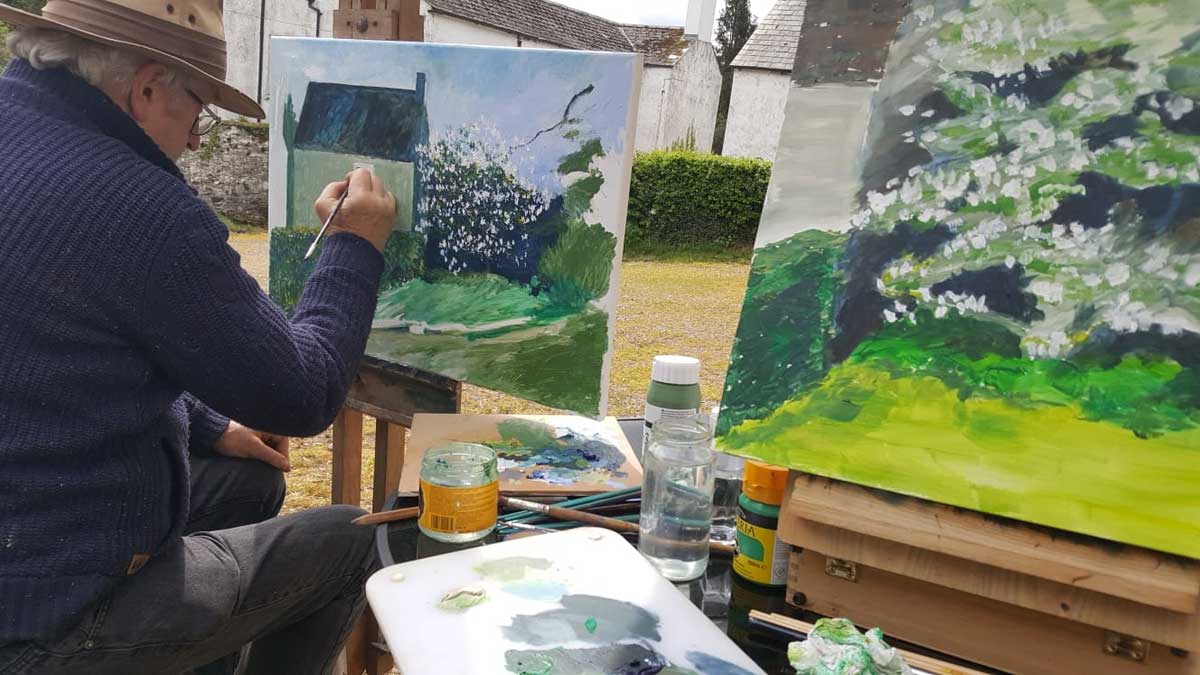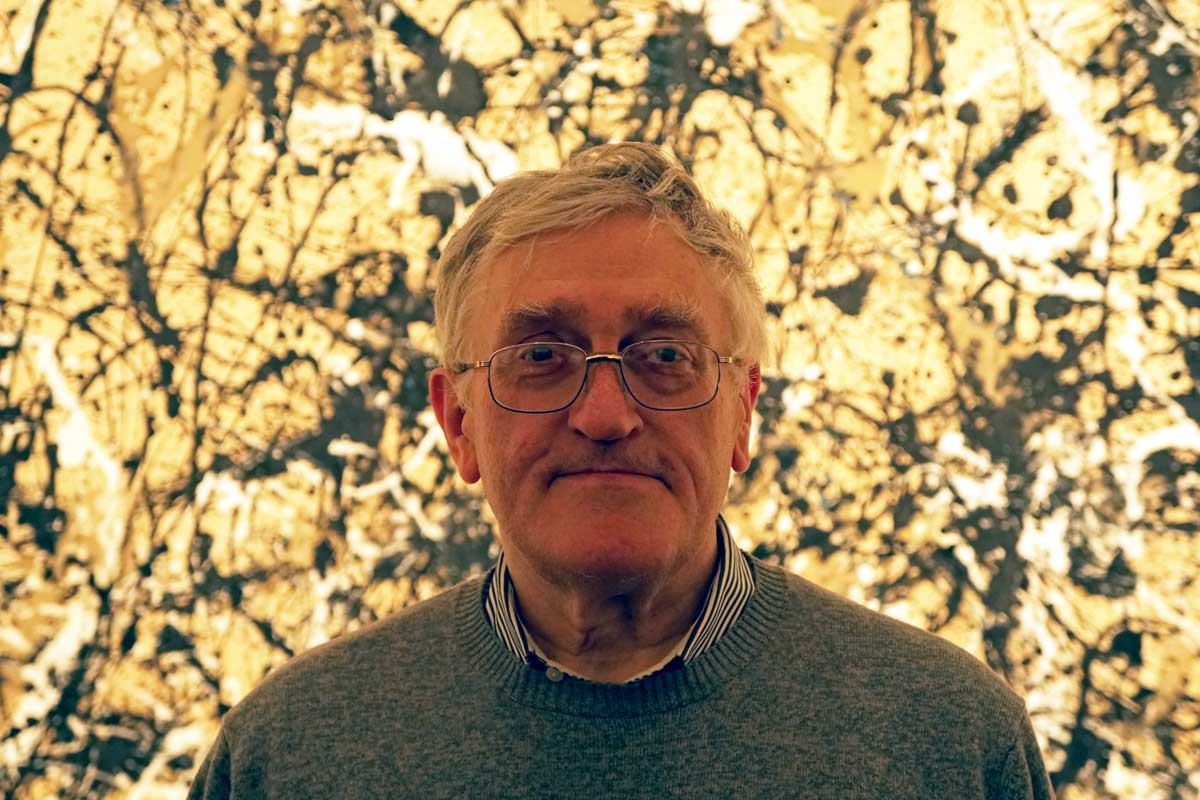Dear Dad,
Do you remember the summer of 2015, when I spent every day studying the weather forecast more intently than ever before? My goal was to find one day when it would not rain, which, as you know, is no mean feat in Donegal, where the Atlantic casts off her relentless deluge in dribs and drabs no matter the time of year. Finally, on 11 September, a dry, albeit windy day was forecast, and so all the necessary preparations were made. You, Mum, Jude, and I arose well before dawn and packed everything we needed into the car. Mum drove us through the slowly dissipating darkness to the top of a nearby hill between Cavanacor and Raphoe, a hill where the prehistoric Stone Circle of Beltany has stood for at least 2,700 and possibly more than 4,000 years. Your grey hair and the charcoal grey suit you wore echoed the immutable standing stones, as you stood with a hot water bottle hidden inside your coat to fight the cold of the westerly wind that barrelled down on us that day.
Jude and I made measurements, set up cameras and chairs, and when all was framed up and ready, I pressed the shutter on my Canon and away we went. You stood firmly in the centre of the picture, where you always liked to be, you would then move an inch to the right and I would reframe the image to keep you central, shouting across the roar of the wind each time I was ready for you to move. We proceeded to do this for nearly 15 hours, from before sunrise until after sunset, with you standing for the majority of that time. Initially we took the photographs about every 5 seconds, but it was obvious, despite your endurance and patience, you would need some breaks to piss, eat, or just sit down briefly. When you were sensing that you needed a break, so as not to interrupt the rhythm of the passing clouds and changing light, we would gradually add several seconds between each shot, building up to an interval of a few minutes. I would shout to Jude, who would then rush over with a chair, a sandwich, or simply to swiftly kick away the sheep shit accumulating on your right shoe as you slid around the interior of the stone circle. Thankfully the sheep were absent this time because they tipped the comical aspect of the project too far when we did the initial test shot back in the spring. You remember our woolly friends were conspicuous through their absence in the form of the soft dark traces they left to be shunted by your shoes. Mum drove up and down the hill with resupplies of hot water bottles, hot tea, and coffee in flasks, bemused concern for your welfare and your firm commitment to the madness of your son and his latest obsession.
What were we doing up there? Playing a game with the concept of time, I suppose? Ranging from the specious present in the rapid click of the camera’s shutter frame to the gap between you and I in years. With me sequestered out of shot, and you firmly planted in the middle of the frame against the backdrop of an ancient circle of monoliths. The animation follows you as you proceed like the second hand on a clock, unmoving in the frame as time passes you by, manifested in the form of the rapidly moving clouds and the changing light (Figure 1). The project was successful, and 15 hours of patient endurance on your part was compressed into a minute of animated footage that has a surreal beautiful resonance, even more so for me now.1 Since your death I’ve had the urge to return to Beltany and undertake a similar project. Except this time at night with you absent from the centre of the frame while the heavens full of their glistening tapestry of stars appear to rotate above the stone circle’s enduring monument to who knows what. This my own fleeting little monument to the void left by the colossal man that was my father.
Over my life and career as an artist, you, my father, Edward (Eddie) O’Kane appeared in many of my artworks. We were also your models and we would set up your easel and art materials in the garden when you wanted to paint. At Halloween, you would draw witches for our schoolmates and us to photocopy and colour in. You patiently posed for my early sketches, paintings, and animations as I learned the craft, and, as all my siblings and your former students know well, you were a perfectionist and a hard man to impress. One of your favourite refrains whenever anyone would present what he or she considered to be their completed work to you for your verdict was that it was ‘a good start.’ This was of course mostly infuriating to us all, but it also drove us to dig deeper into and look harder at the creative task in hand. Out of the frustration it unearthed a sincerer and deeper engagement.
Looking back at the artwork I made using you as my model and inspiration, the resounding theme that emerges time and time again is of you as a monument (Figure 2). Indeed, in one drawing from 2008 and a painting from 2009 you are depicted quite literally as a monument. I then animated the 3-metre tall painting in an endless loop of construction and deconstruction. It is no exaggeration to say that you loomed large in the lives of all those who knew you. You had an endless curiosity about what all of your children did with their lives. At times it could be overwhelming because it was uncertain where you ended and we began. We were extensions of you in some sense. What was one of your greatest strengths could simultaneously be a weakness, though I doubt you would see it that way.
You told us, as an only child, that you always dreamed of a big family. You got one and it was abundantly clear that you loved it and were also at times completely exasperated by it all. You also got the big house you wanted for your big family, Miss Clark’s house. Not Porthall house, which, during your childhood daydreams, you used to stare at longingly over the river Foyle when you visited your granny at the Locks near Strabane. Not that house, but rather Cavanacor House where Miss Clark had later moved, which you found and bought in 1974; yet another piece of the strangely fated story of your life. You spent the rest of your life completely fascinated with uncovering the history of Cavanacor House (Figure 3). All the while, together with Mum and later the rest of your family, you built our own history upon its foundations. It was an artists’ studio, pottery workshop, miniature farm with goats, horses, cats, and dogs, museum, craft shop, tearoom, gardens, a contemporary art gallery but most importantly a magical home. You loved having the historic old house open to the public, sharing your knowledge and love of the place with everyone. Your 20-minute tours could easily turn into two-hour tailor-made affairs if you detected an affinity with your visitors.
You were born on 27 January 1948. I’ve never known a person with better recall, so much so that you confidently proclaimed memories of being in your pram as a baby, and detailed memories at that. Not only was your mind encyclopaedic, but your curiosity and fascination with life in so many of its aspects were unquenchable. It would probably be easier to list the things in life that didn’t interest you rather than attempt to outline the myriad subjects that did.
You appeared quite contradictory in some of your tendencies. You were incredibly gregarious and curious about other people and places and yet also intensely private. You would tell us detailed and surprising stories about yourself or family history at various times. These private stories would inevitably end with your conspiratorial caution not to tell anyone else about them. This complicated relationship to public and private information – a desire to be on intimate personal terms with others, but also a wariness of sharing too much – must partially come from your childhood and adolescence in Belfast. I’m sure you’d resist being psychoanalysed, but it seems to make sense of part of your personality, one shaped by the knowledge that such information could indeed be weaponised and used as a way to place people on sides of a sectarian or ideological divide.
However, there was humour even during ‘the Troubles.’ Sometimes it was dark humour to match the dark times. I remember you telling us about how you and your friends would be bored driving around Belfast in the sixties when one of you would spontaneously suggest, ‘Will we have a funeral?’ Two of the gang would continue to drive the cars very slowly while the other five or six would hoist their fellow conspirator on their shoulders and proceed to walk slowly and solemnly in front. The other traffic would slow and drive by respectfully until they witnessed the ‘body’ and were aghast to see there was no coffin. They would then drive off from this Flann-esque spectacle muttering their disapproval, but also laughing at your black humour in spite of themselves.
You got your ease of talking with anybody from your father (Figure 4) when you helped him collect the coal money and a deep love and respect of family from both your parents. They were late parents. They were in their forties when you arrived on the scene. Your father was born in 1900 and I think Granny in 1906. You came along unexpectedly in 1948 and were their only child. You were really precious to them and Granny was a fantastic person with young children (Figure 5). So you got completely doted on, you were the centre of their world getting everything you could want all through your childhood and teenage years. You inherited a deep faith and respect for the Catholic Church from your parents and internalised your mother’s superstitions and anxieties.
Your superstitions were revealed every time you met someone on the stairs at home. We either had to wait until you had ascended or descended the stairs because you said it was bad luck to pass one another. This seems uncanny in retrospect because that large painting I made portraying you holding burning paper in your hands, ‘The Acuity of Blindness III,’ now hangs above the stairs.2 Now we all pass you on the stairs. Another thing that I find mysterious, yet also somewhat comforting, is that one of the last things that you would have seen before you lost consciousness was a large double portrait I made of you and Mum (Figure 6). You two are depicted from a very high vantage point in the painting seated in your studio. Mum is situated in the foreground of the composition and looks out the window into empty white space, whereas you are seated on the floor in the background looking directly out at the viewer. In your final conscious moments you may well have been looking directly down upon yourself from the perspective I took for this painting. It seems strangely fitting that you may have had a kind of out of body experience through this portrait. It reflects the creative influence you had on your children and so many others and therefore encompasses your legacy in some metaphorical way.
You and Mum went through the art college together, gradually becoming friends. In your final year she invited you to a party, where you both just suddenly felt as though the shades had been lifted off your eyes. You recounted the story at your 50th wedding anniversary, still as in love as you both had been more than half a century before. You and Mum had a completely symbiotic relationship with one another and your home. From the moment you met you did practically everything together, didn’t you? You were always reluctant with change, but when it came and it was successful you adopted it as having been your idea. Starting the gallery in 1999 was a great example of that. Following a suggestion from Eamon, Mum and Marianne established the gallery, then after a few exhibitions and great interest in the venture locally and nationally you embraced it fully. Finally all of the family was involved in some way. For nearly two decades it was one of the most important facets of your life. The gallery allowed for the friendly cultural and intellectual exchange with a wider artistic community that you must have missed from the city. Exhibition openings and the dinner parties that followed became a regular feature of our lives. Your anxiety over each upcoming event would build to a crescendo as we all got the place into shape for visitors, and then it would burst like a dam giving way to your joy at hosting your guests. It brought you so much happiness over the years that you couldn’t bear to let it go, as we all went off in our different directions in life and it became unsustainable.
My engagement with Brian O’Nolan (aka Flann O’Brien) began on my 21st birthday when I received The Third Policeman as a gift from you and Mum. I have that copy on the desk beside me now with your neat copperplate-like written dedication of love from you both. You must have read the novel at a similar age. O’Nolan’s wife Evelyn had the novel published in 1967, less than a year after his death on April Fools’ Day 1966. You would have been nineteen and may well have already read books by Flann O’Brien or Cruiskeen Lawn, his infamous newspaper column under the pen name Myles na gCopaleen. However, I do know that you discussed these books with your friends at Art College in Belfast, meaning you read them in your late teens or early twenties. In any case, they certainly left their mark, and in giving the novel to me you opened or perhaps reopened a Pandora’s box that would continue to occupy us with some of the darker aspects of O’Nolan’s oeuvre for the next sixteen years.
For me, the great revelation about O’Nolan and especially The Third Policeman was that it had elements of absolute genius similar to all the other writers who had intrigued me in our house full of books. Yet he was born in and spent a significant amount of his childhood in Strabane, about 3 miles away from our home at Cavanacor. Genius could be local. The most amazing of inspiration was at one’s fingertips, and not in some far-flung destination in the great beyond. This was a theme you constantly returned to. You had a great interest in the global, but more as a background context to the importance of the minutiae of people and places close to home.
Whilst studying in Germany I was inspired to create a script for a short film, Babble, in which Franz Kafka, Jorge Luis Borges, and Flann O’Brien would all converse using only quotations from their writing in the languages they were originally published in.3 You helped me secure the theatre stage at Letterkenny Art Centre as our shoot location. You and Mum ferried us to and from our accommodation, loaned us one of granddad’s suits, an antique table, and other props. As with so many of our projects, you two were essential to making the film happen. The finished result was, I believe, one of your favourite artworks of mine. You would tell people about it often and seemed to be especially interested in my use of O’Brien as an inspiration and character.
You took early retirement from the Letterkenny Institute of Technology in 2009 and were able gradually to engage more fully with your art practice. In 2011, I heard that there was a Flann O’Brien conference to mark the centenary of O’Nolan’s birth in 1911 and that this was to be held in late July in Vienna. Werner Huber, Paul Fagan, and Ruben Borg were gracious enough to include a screening of Babble as part of the conference. I met Flann’s chief German translator Harry Rowohlt, who was very taken with the short film and dedicated a book of his O’Brien translations to me as a ‘Hyper-realist Filmmaker.’ I couldn’t wait to tell you all about the excitement and interest surrounding what we were led to believe was a lesser-known cult writer from our little forgotten neck of the woods. The local was infiltrating the global. The excitement was contagious, and you also started to make paintings inspired by O’Brien for an exhibition we planned to coincide with the centenary celebration of Flann O’Brien in Strabane. In autumn 2011, these paintings were first displayed in an exhibition at Cavanacor Gallery entitled I Have looked Everywhere That Can Be Looked.4 We also collaborated on an ultimately unsuccessful application to create a monument to O’Brien in Strabane that autumn (Figure 7). However, the digital collage and drawings for the proposal, that I made with your help, ended up becoming the covers of two books: Flann O’Brien: Plays and Teleplays and Flann O’Brien: Problems with Authority.5 So in the end, the monument appeared in different forms.
Keith Hopper, Neil Murphy, and Jack Fennell asked you if they could use your 2011 painting of Flann (Figure 8) on the cover of The Short Fiction of Flann O’Brien.6 They then invited you to read at the House of Commons along with the actress Pauline McLynn. You were very excited to meet her. You were in one of the rooms, with big U-shaped tables and panelling that you always used to watch on BBC 2. You read O’Brien’s ‘Donabate’ beautifully. Afterwards, you all went back to the pub and Keith took a bad turn, he’d had pneumonia and actually had to be rushed off to hospital. The group disbanded and Mum took her friend Mary home. You and Pauline spent the evening talking together, and afterwards she guided you back to the Tube and got you on the right train. Then later, you and Mum went over to London again to the Irish Embassy and met the ambassador at the launch of the book. Keith was there and he was better again, and you were amused and very proud when he told you that you would have the bragging rights associated with the book in perpetuity. You were given plenty of books to bring back. These books were precious to you, and you loved giving them out to the most important people in your life.
You loved meeting famous people. This went right back to your time at St Thomas Secondary School where you were taught by Michael McLaverty. Seamus Heaney also taught there and as a poet was indebted to McLaverty’s mentorship. You later spent a delightful evening in a pub together with Heaney and others, where you likely discussed McLaverty’s influence on you both. Another time, you drove John Hume home from Dublin, and he repaid the favour by inviting you and Mum to dinner with him and his wife. You also swore that you passed Leonard Cohen on a bridge when you were doing research in Leuven. Of course you went to Áras an Uachtaráin as president of the historical society and met Mary Robinson, then President of Ireland (Figure 9). You gave her a piece of Mum’s pottery and later President Mary McAleese also received a piece when she visited Lifford Old Courthouse. You were delighted when Jean Kennedy Smith, US Ambassador to Ireland and John F. Kennedy’s sister, visited Cavanacor (Figure 9). Photographs of these events are proudly displayed throughout the house. You treasured all the portraits that we have at home, you were fascinated with Mum’s family tree and all the history connected with the families, with her former home – Oldbridge House, the Battle of Boyne, the Siege of Derry, and the history of Cavanacor House – and you loved it to be personalised.
Looking back through my messages and diaries, it seems that September 2015 was the time when our artistic collaborations really took off. In that month alone, we created the Beltany animation on 11 September. Then we travelled to Prague on the 13th for the Third International Flann O’Brien Conference from 16–19 September, continued on the 20th to Berlin and Potsdam on the 21st and then on the 26th onward to Ghent and Antwerp, finally returning to Ireland via Brussels on 29 September. In my memory, these projects and trips are much more spread out rather than all taking place in less than three weeks.
We had been to Prague several times over the years. Back in 2008, a painting of Prague’s astronomical clock inspired by a previous visit had won you joint first prize for Painting at the Oireachtas Art Exhibition in Cork. The Third International Flann O’Brien Conference was the perfect reason to return to that beautiful city. Flann met Franz in the many papers we heard as we gathered inspiration for further artwork. You relished the historical tour of Prague we took part in and the fact that the conference ended with a whiskey tasting, where we got to try whiskey similar to what O’Nolan himself would have drunk back in the fifties and sixties.
From Berlin, we travelled on together to Belgium. There we had a wonderful visit to the artist Michaël Borremans’s studio in Ghent. As usual, you developed an exceptional rapport with him in a very short space of time. We then spent a few days visiting the artist Koen van den Broek, staying with him at his studio in Antwerp. During our visit to Koen, we met a professional modern dancer and as usual you fell into a deep wide-ranging conversation and charmed her completely. She was fascinated with our relationship and said it was very rare that an artist would have his father, and fellow artist, as a kind of a muse. It wasn’t a perspective that I had really thought about until then. I remember you speaking with her about your 14-and-a-half-hour feat of endurance at Beltany stone circle, which we had shot a couple of weeks prior. She was mightily impressed and even with her professional training wasn’t sure that she could have accomplished such a long period of standing still on a cold, windy autumn day. You were fond of jokingly calling it a ‘new and unusual form of elder abuse’ and referring to yourself as the eponymous ‘fool on the hill’ from the Beatles song.
In Brussels, we stayed with Sebastian, another friend and artist. Nearby to his apartment, you discovered the Horta Museum. You always discovered hidden gems on our travels. On our way back to Ireland, at Brussels airport, when I presented my ticket to the official, he remarked that I needed new ink for my printer. When you followed closely behind with your ticket he said ‘Oh… you’re together.’ He then asked you about your Claddagh ring. You were happily explaining the history and symbolism in the design of ring when he remarked, ‘But it looks like a bum!’ referring to the love heart shape at the centre of the design, which was inverted for him. From that time on, this became our refrain. When discussing anything aesthetic that we were probably taking too seriously, like some artwork we’d been making, we would undercut one another by simply saying ‘but it looks like a bum!’
Later that autumn, you posed for a series of artworks I entitled ‘The Acuity of Blindness’ which culminated in one of the largest paintings I’ve ever created. It is a huge portrait measuring 400 × 225 cm depicting you, again as a lone colossal figure, holding and gazing upon a burning piece of paper, as though your gaze were the cause of the spontaneous combustion (Figure 10). At your feet the ashes are gathered and the remnants of the paper continue to burn. It is a smaller version of that, yet a large painting in itself, that now hangs above the stairs at Cavanacor.
Our visit to Salzburg in 2017 and the exhibition that Paul Fagan facilitated as part of the Fourth International Flann O’Brien Conference was a wonderful experience for you, Katie, and I (Figure 11). I feel a great debt of gratitude not only to O’Brien for his fantastic writing but to the interest and collaboration of the community that is the International Flann O’Brien Society. The inspiration provided by O’Brien’s writing engendered a wonderful long-term collaboration with you that touched on your many interests and brought us closer in so many special ways. With the support of the society, the artwork had a clear public destination. Thanks to the society, the geographic destinations were multiple and self-perpetuating, casting us back and forth from the very local to the global. You relished every moment of it, the fascinating papers and discussions, the plays and artworks, the drinking and laughing. You really appreciated meeting Stanley and Marsha Gontarski and discussing Samuel Beckett (Figure 11). You had also read Beckett’s short piece ‘Imagination Dead Imagine’ at the launch of my exhibition of artwork for a special portfolio created with Jamie Murphy’s Salvage Press. I remember you getting quite emotional with reading in general and that text in particular.
You secured us sustained access to O’Brien’s birthplace at 17, The Bowling Green in Strabane. The house is in a very dilapidated state. There was a lot of work to be done, simply in order to reclaim some of the rooms from the pebbledash of pigeon shit that had accumulated over the years. You would drive Jude and I back and forth, as we worked on clearing the disgusting mess, and prepared the spaces for use as film sets. The first animated piece we created there was a short vignette depicting a ring of books rotating in a kind of magic circle, which gradually appears to summon a ghostly figure inspired by the character of old Philip Mathers from The Third Policeman.7 You portrayed this character, dressed in your long old coat and flat cap, again waiting very patiently for us to set up each shot before you could pose for the image exposure. Each time you were photographed wearing a different fiberglass mask, which Mum had created from casts of your face and mine (Figure 12). The masks are reminiscent of several motifs in the novel; of the infinite regression of faces the protagonist imagines behind Old Mathers’s countenance, the parchment-like quality of his skin, the transparent gowns the policemen deliver to the parishioners each time they reach a birthday.8 The masks also recall the character from ‘Two in One,’ who wears the skin of his victim until it fuses with his own body.9 They are also somewhat like death masks, and in that sense they embody the uncanny, absurd, funny, yet terrifying afterlife The Third Policeman describes.
You didn’t like to talk about death. This was partially due to your superstitious nature in that invoking the idea would constitute tempting fate. However, I realise in retrospect that we were in fact holding a very lengthy dialogue on that very subject through our explorations of The Third Policeman. The collaborations between you, Mum, and me were a substantial conversation played out through art, addressing an unfathomable subject that we only really skirted around in words. Symbolically, you assumed multiple variations of your persona and mine, created by Mum, which become one shifting disguise through the swift progression of animated images. We were making manifest the unique situation of our family; the creative world fashioned and passed on to us by you, our parents. An ‘ever-widening spiral’10 of a world that we, in turn, handed back to you through the interests you both sparked in us.
You worked steadily on expanding your now substantial body of work inspired by O’Brien (Figure 13) while also supporting me as I continued to create more animated sequences at his birthplace. Christian Dupont, the Burns Librarian, invited us to create an exhibition at the John J. Burns Library at Boston College ‘in far Amurikey’11 and undertake further research into the O’Brien archives held there. We spent about 6 months developing our work for the exhibition Genius of Genre: The Pen Names and Personas of Flann O’Brien.12 Early in 2019, Christian graciously hosted us at his home. We had wonderful evenings and mornings talking with Christian at length about all manner of topics from his deep knowledge of Dante to your experiences during ‘the Troubles’ in Belfast and of course O’Brien. On this trip, we both gave presentations of our work at the opening of the exhibition and to the students studying in the art department at Boston College. You really enjoyed connecting with the students and describing your own experience of school and Art College. And you gave a wonderful interview to other students after attending a conference there on ‘the Troubles.’ The Burns Library and Boston College were very important to you. You had been there in 1996 on a trip for Letterkenny Institute of Technology as industrial liaison officer and around that time had advised Micheál Ó Nualláin, Brian O’Nolan’s brother, to sell the material he had inherited from Evelyn O’Nolan to the library. So you were in no small part responsible for the Burns Library acquiring that archive and it felt cathartic and appropriate that you were able to return and complete that journey. We visited New York and The Metropolitan Museum of Art, where I took photographs of you in front of a huge painting by Jackson Pollock; one of your great influences from your student days (Figure 18).
In spring of 2019, you, Mum, and I created another O’Brien themed exhibition at the Irish Embassy in Berlin: ‘The Epiphenomenal Magic Lantern Show.’ There we met O’Nolan’s goddaughter, who brought with her a lovely letter from the man that made references to her as a baby. Another case of serendipity reminiscent of the many letters and documents we had examined in the archives in Boston.
Unbeknownst to us, the Fifth International Flann O’Brien Conference was to be our last together and the ‘Flanntasmagoria! The Ever Widening Spiral of Flann O’Brien’ exhibition we created for it also ended up being our largest.13 The exhibition took over three floors and the stairwell of Boston College Headquarters on St Stephen’s Green in Dublin. You gave a paper on the ‘The Legend of Stumpy’s Brae’ and Strabane, suggesting links to O’Brien’s early life and writing (Figure 14). I meanwhile presented a paper on the research we had done into Evelyn O’Nolan’s critical role in finally getting The Third Policeman posthumously published. We met so many fascinating people, some relations of the writer and even Evelyn’s niece who had assisted in typing up copies of the manuscript to send to the publishers.
Corona made death very present to everybody. The pandemic was a surreal time for us all and it’s with a shade of guilt that one whispers about the positive side of the experience. From a distance, after the initial panic had subsided and varying degrees of lockdown became our normality, I could clearly see that you and Mum were sequestered in your own paradise. You kept going out for walks together and saying ‘aren’t we so lucky, we’ve it all here and we don’t have to go anywhere.’ Not only that, but you had the gift of one another’s company together with that enormous house and garden (Figure 15). This is especially clear now in retrospect, you two got to be together in a way that could never have happened in normal times. You were so interested in so many things that you would always be heading out to see someone somewhere about something and remaining there talking in great depth for far longer than you had planned. You did, of course, call your children all the time and remain deeply connected with our lives during those strange, holding pattern days.
The reduction in external distractions meant that you focused your attention even more on the pursuit of your own artwork. Curious as ever, you started to learn how to create art using yet another new medium. Together with Mum, you applied for and received a Donegal Cultural and Creativity Grant from Creative Ireland to purchase a 3D printer, a powerful laptop, and funding to pay a mentor to teach you how to use the equipment. With the printer, you created lots of tiny O’Brien inspired sculptures including anthropomorphised bicycles, a series of boxes, each in turn smaller than the other (Figure 16), and a similar series of mirrors that also hinted at the recurring theme of infinite regression in The Third Policeman. You made more paintings and drawings, expanding your subject matter beyond the world of O’Brien, and you continued to read voraciously, always acquiring new books including some very early editions of O’Brien’s novels, even a first edition of The Third Policeman dedicated by Evelyn O’Nolan. This was an important find for both of us in light of our research into the O’Brien archives at Boston College, where we had discovered the extent of her efforts in securing the faithful publication of O’Brien’s best novel.
We all felt so proud of you as you worked hard on making new artwork, staging exhibitions in spite of the pandemic. In the last four years of your life you won four awards, two from Creative Ireland and two from the Arts Council. In 2019, we had exhibitions in Boston, Berlin, and Dublin. In 2020 and 2021, you also organised and staged two exhibitions, one at Lifford Old Courthouse, a building that you had been instrumental in saving from demolition, and a final exhibition at the Alley Arts Centre in Brian O’Nolan’s hometown of Strabane. You brought your internationally acclaimed artwork home to celebrate that cross-border locality that was so important to you. It was wonderful to see you flourishing like this, bringing your work full circle and achieving the recognition of your worth and abilities that you truly deserved.
In the midst of this renaissance in your artwork, you disappeared suddenly from our lives. No warning, no farewell. Death came as a terrible absence, a void, our own emptiness embracing the unknown.
For your final departure from Cavanacor, I chose the beautiful song ‘Ghosteen Speaks’ by Nick Cave. As we slowly carried you down away from the house that was so very important to you, Cave’s voice followed behind. The hauntingly beautiful lyrics and sounds floated down the driveway carrying you and the mourners away from the mansion on the hill:
I am beside you, look for me
I try to forget, to remember that nothing is something
Where something is meant to be …
… I am within you, you are within me
I am beside you, you are beside me
I think they’re singing to be free, I think they’re singing to be free,
I think my friends have gathered here for me.
All those years of preparing exhibitions for the gallery meant that the muscle memory seemed to kick in for everyone and they all seamlessly assumed the various necessary tasks, channelling their grief into a ritual somewhat like an artwork in itself. I definitely feel that I dealt with that time like a piece of artwork. I suppose it was the only defence mechanism I could muster.
In spite of the suddenness of your death and the lack of any plan for the event, your funeral turned out to be truly beautiful. Your final painting was on display. The painting of the magnolia tree planted in memory of your son, our brother Peter who died very young. It sat before the altar together with a painting of the same tree, which mum made working side by side with you on a sunny Spring day (Figure 17). Your children and grandchildren provided readings, songs and music. A close friend of Marianne’s also sang Leonard Cohen’s ‘Hallelujah’ as we carried your body out of the church. I remember very clearly the lyric of the song as we passed out through the doors, which seemed absolutely fitting given the suddenness of your death and the strength of your faith:
And even though it all went wrong,
I’ll stand right here before the Lord of song,
With nothing, nothing on my tongue but Hallelujah.
Practically everything went right in your life except, tragically, the final act was cut short so suddenly. I was lured into a false sense of security believing that we had at least ten, if not twenty years left with you. There would be time to slowly interview you and record all of your fascinating stories, to assist you in weaving together a coherent narrative from the rich tapestry of your life. Finally we would document that intricate web of connections, which you had the unique talent of not only seeing but also remembering. Alas, the fact that you were always so ready to talk at length on so many subjects led me to believe that there would always be time. This was a process that I had finally elected to begin in February of last year. Of course, because you always assumed the storytelling helm, I insisted that we interview Mum first. As we interviewed her, you were off camera ready to fill in the blanks if she couldn’t recall something as exactly as you could. I had admonished you not to interrupt or take over and you were respectfully, though probably somewhat uncomfortably, silent. Now that silence is deafening.
We are here to sift through the remains of our own recollections like some archaeological dig where a colossus that had been unearthed and maintained for decades unexpectedly shattered into infinitesimal pieces. Thankfully, your gregarious nature meant that many people knew you well and we will have countless perspectives to draw upon in our process of slow and careful re-assemblage. I am grateful too for the fact that, although I have not, some of your children have inherited part of your gift for memory. There are experts on site and the work will go on for the remainder of our lives and beyond.
Past humanity is not only implicit in each new man born but is contained in him. Humanity is an ever-widening spiral and life is the beam that plays briefly on each succeeding ring. All humanity from its beginning to its end is already present but the beam has not yet played beyond you.14
Thank you for being our teacher, our friend, our father.
With all my love,
David
Postscript
A short note to Daddy,
David and I originally planned to write a piece together on our recollections of you, but his task evidently became fully infused with your spirit as he went into intricate detail on every part of your collaborative journey. I just want to tell you that you have made me the person I am. Every day we spent together I enjoyed. In my childhood I wanted to go everywhere with you; it didn’t matter where, whether it was sharpening a chainsaw blade in Strabane, visiting relatives in Woodend Road, or going to the paper shop. We spent a long time there after Sunday mass, just browsing the shelves of comics and papers, never in any rush. Before mobile phones, time had a different quality, and there were no interruptions. Like you, I loved talking to everyone, remembering names and considering details, points of comparison. In more recent times while working on my PhD, myself and my daughters spent time with you and Mum at Cavanacor over a number of weekends. I marvelled how, as I came in the back door, you would embrace me and then begin talking seamlessly from topic to topic that you knew specifically interested me. You spoke at length; almost without pause. Sometimes an hour or two would pass and still you would be talking, trying to cover all the ground of the week between. I am proud to say that I never took a single moment of our time together for granted and you knew this; it has all been special, filled with love, pride, and an admiration for you. You brought everything I did to life, Daddy. After you passed away, I remember seeing all my work and projects as dull lead. I wondered how I can ever enjoy anything again without you. My godmother Therese suggested I bring you to mind with your encouraging remarks to spark that interest again. It works, and I can hear your voice in my head; you guide me daily. When things have been hard for us over the years and I have asked you for help, you always repeated the same advice; ‘just don’t forget your prayers.’ Like you, they are embedded in the fabric of my daily life and now you are remembered in these prayers,
with love always,
Marianne
Notes
- David O’Kane, ‘Beltany,’ HD animated video (2015): http://www.davidokane.com/2015-beltany-animation.html. [^]
- David O’Kane, ‘The Acuity of Blindness III,’ 150 × 100 cm, oil on canvas (2015): http://www.davidokane.com/2015-the-acuity-of-blindness.html. [^]
- David O’Kane, Babble, film (2008): https://vimeo.com/251624861. [^]
- Edward O’Kane, ‘I Have Looked Everywhere That Can Be Looked: Bloomsday 60,’ The Parish Review: Journal of Flann O’Brien Studies 2, no. 2 (Spring 2014): 45–6. Available at: https://doi.org/10.16995/pr.3358. [^]
- Flann O’Brien, Flann O’Brien: Plays and Teleplays, ed. Daniel Keith Jernigan (Champaign, IL: Dalkey Archive Press, 2013); Flann O’Brien: Problems with Authority, eds. Ruben Borg, Paul Fagan, and John McCourt (Cork: Cork University Press, 2017). [^]
- Flann O’Brien, The Short Fiction of Flann O’Brien, eds. Neil Murphy and Keith Hopper, trans. Jack Fennell (Champaign, IL: Dalkey Archive Press, 2013). [^]
- David O’Kane, ‘ 17 The Bowling Green,’ high definition animated video (2017): https://vimeo.com/227464560; ‘The Third Policeman (Work in Progress),’ high definition animated video (2017): http://www.davidokane.com/2017-the-third-policeman.html; ‘The Third Policeman,’ high definition animated video (2019): http://www.davidokane.com/2019-the-third-policeman.html. See also the cover of Flann O’Brien: Acting Out, eds. Paul Fagan and Dieter Fuchs (Cork: Cork University Press, 2022). [^]
- Flann O’Brien, The Complete Novels, introd. Keith Donohue (New York: Everyman’s Library, 2007), 239, 246–7. [^]
- Myles na Gopaleen, ‘Two in One,’ The Bell, vol. 19, no. 8, July 1954, pp. 30–4; republished in O’Brien, The Short Fiction of Flann O’Brien, 84–9. [^]
- O’Brien, The Complete Novels, 308. [^]
- O’Brien, The Complete Novels, 270. [^]
- Genius of Genre: The Pen Names and Personas of Flann O’Brien, Boston College Libraries, Burns Library Exhibit, https://library.bc.edu/exhibits/2019/01/genius-genre/. [^]
- Marianne O’Kane Boal, ‘Review of “The Ever Widening Spiral” at the Alley Theatre and Strabane and Sperrin Visitor Information Centre, 27 September–15 October 2021,’ The Parish Review: Journal of Flann O’Brien Studies 5, no. 2 (Spring 2021): 1–18. Available at: https://doi.org/10.16995/pr.8257. [^]
- O’Brien, The Complete Novels, 308. [^]
Competing Interests
The authors have no competing interests to declare.
